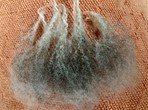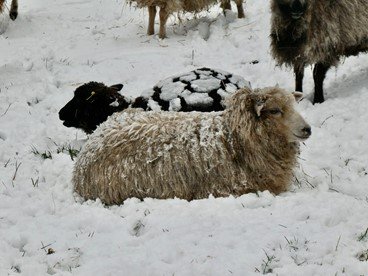Not All Shetlands Are Double Coated
words and photos by Lynne Peachey

Recently, there has been much discussion on social networks concerning the Shetland sheep being double coated. But not all Shetlands are double coated, so spinners should be aware of the product they can expect when ordering a Shetland fleece for spinning.
Generally, in the UK the Shetland sheep in not dual coated. The fleece is very fine, of medium length staple, and with a soft handle. This type of Shetland could be considered the “classic” type.
During the latter part of the past century, breeders on the UK mainland, adhering to the Shetland Flock Book Society Standard and tradition have bred to maintain a fine-wooled, single-coated phenotype reflecting the best that Shetland had to offer.
The 1927 Standard which breeders work and show to states, “Wool – Extra fine and soft texture, longish, wavy, and well closed.” Judges look for around 10 crimps per inch when selecting a show winner.
The Shetland sheep is a primitive sheep, which means it is very hardy, surviving outside during winter when some commercial breeds would need to be housed. They also browse on various vegetation rather than depending on only lush grass. Having said that, it is believed that sheep with this fine fleece would not survive into old age on Shetland. And it is on the island of Foula (one of the Shetland isles) where this “double coated” type would be particularly found experiencing even wilder weather!
Some Shetland breeders sell their older ewes to a more southerly environment where it is not such a challenge to survive the winter.

On my visits to Shetland, I did note that some flocks bred for meat production have been progressively selected to provide a larger animal. These are still Shetland sheep but provide more meat and a larger, good single-coated fleece. I processed a beautiful large white fleece which I spun as a double knit equivalent and knitted a hip-length aran jumper. This fleece weighed about 3k, whereas the general Shetland on the mainland may yield about 2k.
Pure-bred Shetland sheep tend to shed their fleece in spring (sometimes starting as early as February!). The growth of new fleece can cause a rise or break, and where this is present the fleece can be plucked or rooed by hand. This process does not hurt the sheep, and in fact some of the older ones enjoy the process as we would with a spa treatment! The timing of this can be different in each individual sheep. Rooed fleece can be amongst the softest because the fibres have no harsh cut ends as occurs with a sheared fleece, and since it is not shorn, there are no second cuts!
For more information and pictures about the different types of Shetland fleeces, see Shetland Fleece Types on the North American Shetland Sheepbreeders Association website.
Did you know we also have a monthly PLY newsletter? Sign up here!
PLY Magazine believes that Black lives matter, as well as LBGTQI+ lives. Those most vulnerable and persecuted in our communities deserve our love and support. Please be good to each other.





Leave a Reply
Want to join the discussion?Feel free to contribute!